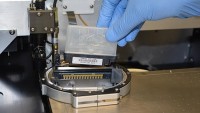 The ink can be printed onto surfaces with an inkjet printer, and contains microscopic ceramic cubes 10,000 times thinner than a human hair, which digitally store information in binary code.
The ink can be printed onto surfaces with an inkjet printer, and contains microscopic ceramic cubes 10,000 times thinner than a human hair, which digitally store information in binary code.
The cubes are made from the rare earth mineral cerium oxide and are roughly 10 nanometres thick, Daily Pakistan reported. Two trillion cubes could theoretically fit into a memory cell the size of a standard postage stamp.
Another news report by Proactive Investors Australia suggested that the development of the technology is part of a programme being undertaken by Strategic Elements, a pooled development fund for the technology sector.
Sean Li, of the University of New South Wales School of Materials Science and Engineering, said the transparent ink’s cubes self-assemble when placed in a solution and printed onto a conductive surface. Scientists are also working on transparent transistors, a transparent power supply, transparent memory, as well as a transparent display for a “transparent computer”.
Managing director Charles Murphy, Managing Director of Strategic Elements, which has been granted a license to develop and commercialise the technology, said the printed electronics industry is projected to grow to about $78 billion (€69.4 billion) by 2023.
He said: “From our perspective, we had a technology with a global market that is unlike anything else available, developed by a team of passionate researchers at the number one materials science school in the country.
“This is a completely different way of potentially providing high performance memory.”
